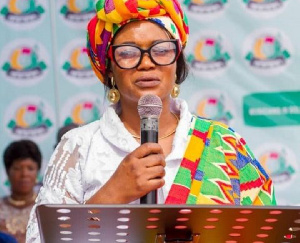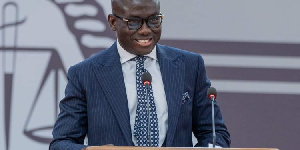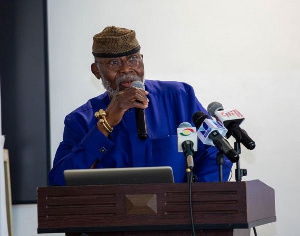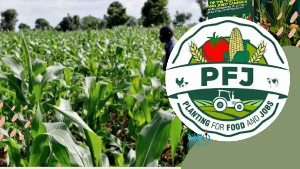Opinions of Monday, 1 October 2012
Columnist: Mubarik, Abu
Quality Of The Ghanaian Education
Research has shown that “in many parts of the world, an enormous gap prevails between the numbers graduating from schools and those among them who can master a minimum set of cognitive skills” (Education For All: The quality imperative, 2005 p. 23)
One of Ghana’s education policy goals is to improve the quality of teaching and learning for enhanced pupil/student achievement.
The Netherlands Organisation for International Co-operation in Higher Education conducted a study on the Ghanaian Education system and made the following revelations in April, 2011.
Pre-tertiary education
Pre-school education caters for children from three to five years of age and is not compulsory. However, in order to ensure that nursery schools are properly conducted, the government established a National Nursery Teachers Training Centre where certified teachers who wish to specialize in nursery education can receive training for up to three months (UNESCO, 2006). Basic education is compulsory and free of charge and is made up of six years of primary school and three years of junior high school. The subjects taken by all primary school pupils are: mathematics, science, social studies, cultural studies, Ghanaian languages, English, agriculture, life skills and physical education. The medium of instruction is English at all levels of education except the first few years of primary school where the main Ghanaian language of the region is used. No entrance examination is required for admission to junior high school. Basic education is followed by four years of senior high school, which is not compulsory but is subsidized by government. Senior high school has four parallel education streams (i.e. general education, vocational education, technical education and agricultural education) with a core of compulsory subjects in the first two years (i.e. mathematics, computer studies, general science, social studies and English; Ghana MOESS, 2007).
Pre-tertiary level technical and vocational education in Ghana historically takes place in two distinct environments: formal education environments and informal training environments (Duodu, 2006). The formal TVET sub-system consists of institutions that provide classroom and workshop-based instruction. They follow written curricula and students take formal examinations for which certificates are awarded. Informal TVET covers the traditional apprenticeship system, on-the-job training and all skills-training activities that do not lead to formal certification. Formal TVET at senior high school level is provided by technical secondary schools and technical institutes (Annex A, Table A1). Technical secondary schools offer General Certificate of Education Ordinary Level (GCE O-Level) and occasionally GCE Advanced Level (GCE A-Level) courses as well as a range of technical, vocational and commercial subjects. For entry to these schools, the Common Entrance Examination must be taken as is the case for all education institutions in all four educational streams at secondary level. Technical institutes offer pre-technical and general technical and craft courses in the engineering and building sciences. The pre-technical course requires two years of full-time study and includes general education as well as introductory technical and craft courses. Students may then take up an apprenticeship or continue with further technical education, either in the general technical courses or the craft courses (Figure 2.2.1.1). General technical courses have a considerable theoretical content while the general craft courses have a high practical content. Both courses require two years of full-time study after the pre-technical course and prepare students for CGLI (City and Guilds of London Institute) Examinations. Completion of the general technical or craft programme is considered comparable to completion of the technical secondary school programmes in Ghana. On completion students may continue to polytechnics for more advanced technical education or take up apprenticeships. Some technical institutes also offer three-to-five year secretarial and commercial courses which lead to Royal Society of Arts (RSA) and WAEC (West African Examinations Council) awards.
For primary school students who do not proceed to senior high school (i.e. 60% [Ghana MOESS, 2008]), a variety of apprenticeship and training programmes and various forms of adult education are offered by private colleges or colleges run by various ministries. Some of the students are also directly absorbed into the workforce, especially in agriculture. Most senior high school graduates directly enter employment, especially if they followed the more vocational and less theoretical forms of secondary education. The Government of Ghana (GoG) is currently paying special attention to teacher education and is particularly aiming to increase the number of qualified teachers at all levels of the school system. The 2007 Education Reform Program (Ghana MOESS, 2007) provides untrained teachers in primary schools with access to remedial courses through distance education. Teachers at primary level complete a three-year pre-service Diploma in Basic Education (Basic Education Programme A) at a Teacher Training College (TTC) while junior secondary school teachers do the same at a TTC or university. In-service training for both primary and secondary school teachers is provided. There are also degree programmes available for senior high school teachers (i.e. subject specialists) and tutors for Teacher Training Colleges. In 2008, there were approximately 38 public and three private TTCs located across the ten regions of Ghana, with a total enrolment of 26,025 trainees (Ghana MOESS, 2008). New graduates are compelled by the Ghana National Service Corps to teach their specialized subject in rural areas.
The education system in Ghana is based on the British model and is considered to be one of the best in the West African region. Since there are significant variations in the quality of schools, collective examinations play an important role in maintaining educational standards. The WAEC administers the national examinations, including entrance and final examinations for secondary schools and teacher training colleges. It ensures that educational standards are maintained at their United Kingdom (UK) equivalents. Senior high school graduates hold the WAEC senior secondary certificate, which is equivalent to the UK matriculation standard, requiring a combination of passes at GCE O-Level or equivalent and at least two subjects at GCE A-Level or equivalent. Ghanaian higher education institutions also have strong relationships with British universities and participate actively in the international academic community (UG, 2009).
Tertiary education
Higher education in Ghana is offered at universities and institutions for higher professional education. Theoretical education is offered by both public universities and private national or international universities, while professional education is offered at the ten national polytechnics and several national or international specialized colleges that are affiliated to some of the local universities for the award of professional bachelor and postgraduate degrees.
These lists are particularly useful when comparing the disciplinary focus of the training courses on offer in Ghana with the skill needs of the local labour market as articulated by employers during personal interviews, to see if they match.
Higher professional education: is offered at polytechnics and specialized colleges. Polytechnics have not always been part of the tertiary education system in Ghana and were only upgraded to this level in 1992 through the Polytechnics Law (PNDC Law 321; Ghana MOESS, 2008). In contrast to universities, polytechnics prepare students for practice-oriented middle-level professions. Entry into polytechnics requires a senior high school leaving certificate from a technical secondary school or completion of general technical or craft courses at a technical institute. Courses offered are based on CGLI courses but lead to local examinations resulting in the award of advanced technician and craft certificates or the Higher National Diploma (HND). In some disciplines and polytechnics, holders of the HND can continue their study for approximately two years to obtain the Bachelor of Technology (B.Tech) degree. In Ghana, the B.Tech degree is the highest obtainable professional qualification with a strong practical component. Further specialization requires studying abroad. The HND and B.Tech correspond to Levels 6 and 7, respectively, which are the highest levels that can be achieved in the Ghanaian national qualification framework for TVET. The Level 6 qualification indicates considerable theoretical knowledge and solid practical skills. Sophisticated application of technical knowledge is expected at this level. Level 7 indicates a high level of technical competence, conceptual knowledge and professional skills in a broad range of activities in complex and changing contexts (Addy, 2008).
In addition to polytechnics there are also public and private specialized colleges which operate at post-senior high school level and offer professional courses ranging from three months to three years. Admission requires the senior high school leaving certificate or equivalent and/or work experience. The courses include substantial practical work and usually lead to the award of a certificate from the college and/or the relevant government ministry running the college.
The Education Sector Performance Report (ESPR) is based on the National Education Sector Annual Review (NESAR) which was instituted with the implementation of the country’s Education Strategic Plan (ESP) 2003-2015 (Ghana MOE, 2003). The ESPR (Ghana MOESS, 2008) is a source of various comparative statistics and information for the education sector, for instance on access to education, quality of education, education management, education finance, and the state of science and technology and TVET.
Some summary statistics for the Ghanaian education sector.Issue Statistic
Total national population (2006):
Urban population1 Rural population Mean household size 22.2 million (of which 51.5% are female)8.4 million13.8 million
4
Number of pre-tertiary education institutions: Kindergarten (2007/2008)
Primary schools (2007/2008) Junior secondary schools (2007/2008) Senior secondary schools (2007/2008) 42,97115,449 (of which 28% are private)
17,315 (of which 24% are private) 9,507 (of which 24% are private)700 (of which 30% are private)
Number of tertiary education institutions (2009): Universities Polytechnics
Other specialised post-secondary professional education institutions 33 (of which 81% are private)
10 (all of which are public)
At least 130 (public and private)
Pre-tertiary enrolment:
Kindergarten enrolment (2007/2008)
Primary school enrolment (2007/2008)
Junior secondary school enrolment (2007/2008)
Senior secondary school enrolment (2007/2008)
Primary and junior secondary school attendance (2008) 6,564,633
1,262,264 (of which 17% in private sector)
3,622,724 (of which 18% in private sector)
1,224,964 (of which 17% in private sector)
454,681 (of which 13% in private sector)
86% of school-going age population
Total known tertiary enrolment (private and public institutions in 2006/2007):
Public university enrolment (2006/2007)
Private university enrolment (2006/2007)
Tertiary level professional institution enrolment (2006/2007)
Polytechnic enrolment (2006/2007)
No. of 15–24 year olds (tertiary training age) in total national population (2007) 139,768 (of which 34% are female)
88,445 (of which 34% are female)
18,278 (of which 39% are female)
4,350 (of which 46% are female)
28,695 (of which 30% are female)
5 million
Education completion rates:
Primary completion rate (2007/2008)
Junior secondary school completion rate (2007/2008)
Senior secondary school pass rate (2007/2008)3
University completion rate
Polytechnic completion rate 88%
68%
40%
no statistics
no statistics
Student-to-teacher ratios:
Pre-school student-to-teacher ratio (2007/2008)3
Primary school student-to-teacher ratio (2007/2008)3
Junior secondary school student-to-teacher ratio (2007/2008)3
Senior secondary school student-to-teacher ratio
University lecturer-to-student ratio
Polytechnic lecturer-to-student ratio7 52:1
35.1:1
17.4:1
no statistics
no statistics
56:1
Percentage of untrained teachers:
Kindergarten (2007/2008)3
Primary school (2007/2008)3
Junior secondary school (2007/2008)3
Senior secondary school 43%
59%
76%
no statistics
Budget
Total national budget (2010)
Total national education budget (2010)
Recurring costs (2010)
2008 education budget spent on pre-school education
2008 education budget spent on primary education
2008 education budget spent on junior secondary school
Education budget spent on secondary education (2010)
Secondary education budget spent on secondary TVET (2010)
Education budget spent on higher education (2010)
Higher education budget spent on polytechnics (2010)
2008 education budget spent on teacher education
2008 education budget spent on special education
2008 education budget spent on non-formal education
2008 education budget spent on management GH¢ 7,496,376,856
GH¢ 2,056,143,338 (27.4% of total national budget)
GH¢ 1,668,053,910 (81.1% of total education budget)
4.5%
36.7%
18.6%
12.6% (GH¢ 258,728,803)
8.7% (GH¢ 22,449,911)6; = 1% of total education budget
23% (GH¢ 472,912,968)
17.4% (GH¢ 82,286,856); = 4% of total education budget
3.8%
0.8%
0.6%
0.8%
*Measurement of the quality of education in Ghana has focused principally on resource inputs and outcomes (i.e. PTR and BECE results)
The Ministry’s broad policies and strategies since 1996 have been effective in promoting positive trends in access and reducing the barriers to access for Ghana’s school-going children especially girls, but quality improvement in education is yet to show positive trends
There is a general perception in Ghana that educational standards are low in public schools in both urban and rural areas compared to private schools
Since Coleman and his colleagues’ report on school effectiveness in 1966, debate on education quality has been dominated by two schools of thought, namely, the effective schools approach and schools improvement approach.
A research conducted by Dr. Joseph Ghartey Ampiah (University of Cape Coast Ghana) on the Investigation of Provision of Quality Basic Education in Ghana revealed the following findings:
• In all the 24 classes observed, the size of only six of them came close to the PTR of 35:1. In 12 of the classes, class sizes were above 50 making individual pupil-teacher interactions difficult. The PTR of 25:1 was not met by any of the school types at the JSS level.
• In all the school types, head teachers did not readily mark lesson notes. In the private schools out of 51 lesson notes seen, only 6 (11.8%) had been marked. That of the rural schools was 11 (31.4%) out of 35. The case of the urban schools was far better with 68 (71.6%) out of the 95 lesson notes marked. There were however, many errors in the lesson notes that were not indicated as errors by the head teachers.
• Official school time tables showed that a lot of time was expected to be devoted to the study of English language and mathematics at both primary and the junior secondary school levels in all school types. In practice teachers used even far more time than indicated on the time tables for these two subjects. Also, some lessons took more time than stipulated on the time table whilst others took lesser time. The situation was worse at the primary school level but this practice seemed acceptable in all the schools studied
• A mixture of English language and Ghanaian language was used more often during classroom instruction by teachers in the rural schools (43.5%-66.7% of lessons observed) compared to 11.4-37.1% in urban schools and 3.4%-7.7% in private schools.
• The use of English language only among pupils in the classroom was dominant in the private schools. In the urban schools, the use of English language only by pupils was observed in 11.4%-60.0% of the total number of lessons. Generally, English language facility of pupils in the rural schools was lower than their counterparts in the urban and private schools in that order.
• The use of the “chalk and talk” method of teaching was observed in all school types but was more dominant across primary 3 to primary 6 in the rural schools.
• At the JSS level the “chalk and talk” method was observed to be more dominant in the rural schools (83.4%) followed by the urban schools (73.4%) and the private schools (47.3%). The use of demonstration method was higher in the urban schools compared to the rural and private schools in that order.
• In the rural schools, teachers were the ones who asked the most questions in all the 60 lessons observed. In the private schools it was observed that in 86 out of the 94 lessons (91.5%), teachers asked more questions than their pupils. In the case of the urban schools, it was 103 out of 111 (92.8%) and in the rural schools in all the 60 lessons observed.
• Majority of pupils in private (95.3%), urban (85.4%) and rural schools (93.1%) interviewed said that their teachers copied notes on the chalkboard for them to copy into their notebooks. Teachers also dictated notes for pupils to copy in all school types.
• The use of practical activities (hands on activities) was not the norm in all the school types where lessons were observed. In the urban schools it was observed that in 48 out of the 111 lessons (43.2%), pupils were engaged in practical activities during the lesson. In the case of the private schools it was 12 out of 94 (12.8%) and 10 out of 60 (16.7%) of lessons observed in the rural schools.
• Textbook situation in the private schools was far better than that in the public rural and urban schools. Majority of pupils in the private schools had access to textbooks in six out of eight subjects; in the public urban and rural schools pupils had textbooks in only three out of eight subjects. Most pupils in the private schools had their own textbooks whilst most textbooks in the public schools were for the school.
In a nutshell, the research concluded that;
• The quality of education offered by the private, public (urban and rural) schools studied were hampered by many problems and shortcomings such as lack of textbooks, inappropriate teaching methods, lack of TLMs and the extensive use of English as the language of instruction.
• The major differences between private and public schools are the superior English language facility of the pupils; greater availability and use of textbooks by pupils; and more access to whole-class extra classes as well as special tuition for pupils in private schools.
• Aside these factors, there was not much to choose between the public and private schools. The public urban and rural schools studied had similar characteristics apart from the English language facility which was better in the urban schools than the rural schools.
ACRONYMS
AGI Association of Ghana Industries
COTVET Council for Technical and Vocational Education and Training
CIDA Canadian International Development Agency
CGLI City and Guilds of London Institute
DANIDA Danish International Development Agency
ESP Education Strategic Plan
ESPR Education Sector Performance Report
EU European Union
FTC Full Technological Certificates (CGLI)
GATT General Agreement of Tariffs and Trade
GEA Ghana Employers Association
GES Ghana Education Service
GCE A-Level General Certificate of Education Advanced Level
GCE O-Level General Certificate of Education Ordinary Level
GHS Ghana Health Service
GNCCI Ghana National Council of Commerce and Industries
GNPC Ghana National Petroleum Corporation
GoG Government of Ghana
GPRS I Ghana Poverty Reduction Strategy
GPRS II Growth and Poverty Reduction Strategy
GSS Ghana Statistical Service
HND Higher National Diploma
IMF International Monetary Fund
ITC International Trade Centre
JICA Japanese International Cooperation Agency
MDG Millennium Development Goal
MESW Ministry of Employment and Social Welfare
MFA Ministry of Food and Agriculture
MOE Ministry of Education (current)
MOESS Ministry of Education, Science and Sports (dissolved)
MOH Ministry of Health
NAB National Accreditation Board
NABPTEX National Board for Professional & Technician Examinations
NAP National Apprenticeship Programme
NCTE National Council of Higher Education
NEP National Employment Policy
NESAR National Education Sector Annual Review
NICHE Netherlands Initiative for Capacity development in Higher Education
NPT Netherlands Programme for Institutional Strengthening of Post-secondary Education and Training Capacity
OTD Ordinary Technician Diploma
RSA Royal Society of Arts
TTI Technical Training Institute (secondary education level)
TVET Technical and Vocational Education and Training
UN United Nations
UNIFEM United Nations Development Fund for Women
UNCTAD United Nations Conference on Trade and Development
WAEC West African Examinations Council
WTO World Trade Organisation
Entertainment









